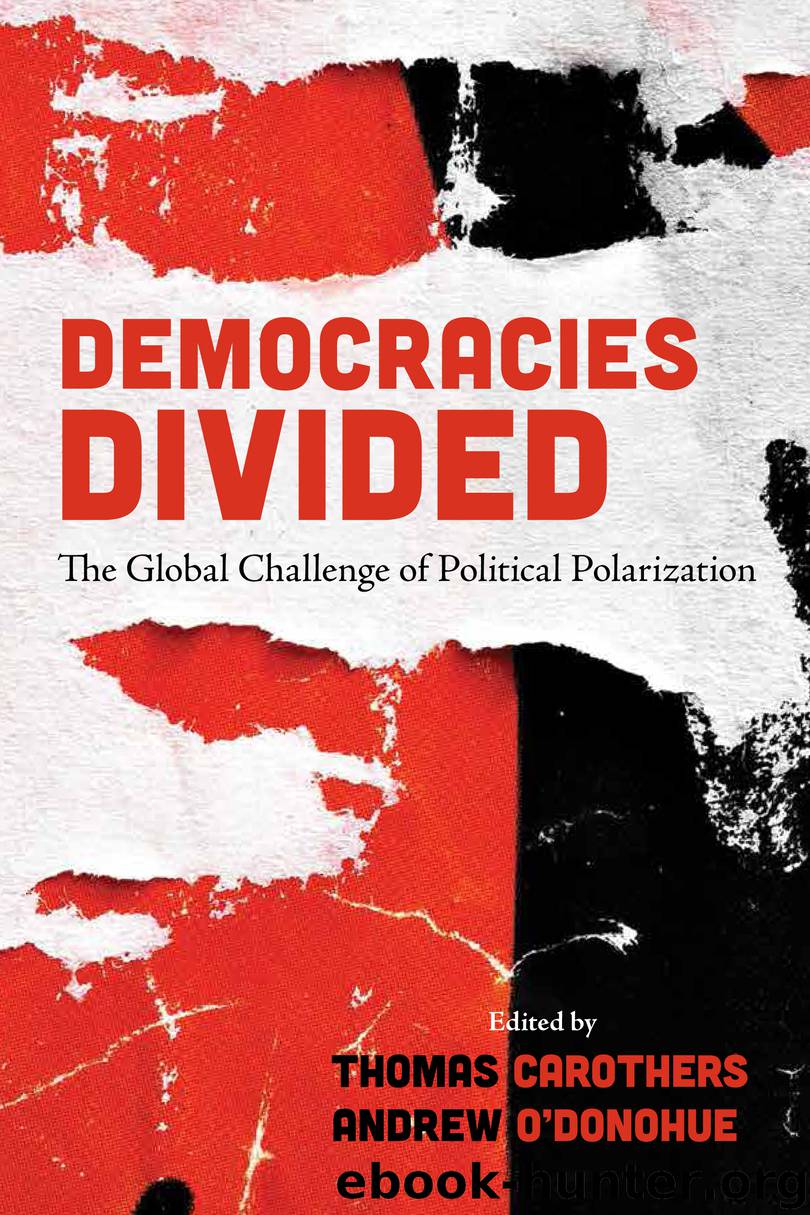Democracies Divided by Thomas Carothers

Author:Thomas Carothers
Language: eng
Format: epub
Publisher: Brookings Institution Press
Part III
ELITE POLARIZATION IN RELATIVELY HOMOGENOUS SOCIETIES
SIX
Colombia’s Polarizing Peace Efforts
ANDREAS E. FELDMANN
Colombia has long suffered intense periods of political and social polarization rooted in core issues of socioeconomic exclusion and the distribution of power. In the past ten years, polarization has once again flared up, fueled by conflicting views on how to end the long and bloody internal armed conflict that has consumed the country since 1964. The 2016 Peace Accord between the administration of President Juan Manuel Santos and the Revolutionary Armed Forces of Colombia (Fuerzas Armadas Revolucionarias de Colombia; FARC), the country’s most emblematic and strongest guerrilla group, is the focal point of this new phase of polarization. In the 2018 presidential election, sharp disagreement over the future of the peace accord and its purported impact on the country produced the most polarized election in the country in recent decades. The winner of the election, Iván Duque of the right-wing Centro Democrático, openly criticized the accord and suggested that he might substantially amend it, while his second-round opponent, Gustavo Petro of the leftist Progressive Movement party, strongly supported it.
Colombia represents yet another instance of a growing global phenomenon in which polarization transforms social and political relations into “two unyielding hostile factions.”1 In its concentration around the issue of peace, however, Colombia’s polarization differs within Latin America from the pattern of polarizing populism that arose in the 2000s, which was marked by the emergence of radical leftist reformers who gained power and challenged fundamental elements of the political system, as seen in Bolivia, Ecuador, Honduras, Nicaragua, and Venezuela.2 Colombia also differs from the recent Brazilian experience characterized by the emergence of right-wing populism (see chapter 9 in this volume).
This chapter examines this new phase of polarization in Colombia, arguing that even though it is an elite-driven phenomenon, it has been spreading into the wider society through loyalty ties to uncompromising political factions. The roots of Colombia’s contemporary polarization lie in a lengthy history of political violence, first between competing political camps and then between armed guerrilla groups and the Colombian state and paramilitary groups supporting its counterinsurgency efforts. Political polarization over peace negotiations, however, has intensified in the past two decades and is largely the result of elite-level divisions. In particular, three aspects of the 2016 Peace Accord—justice for past crimes, political participation for former guerrilla leaders, and land reform—have been intensely polarizing. As for the main consequences of polarization, Colombia has managed to avert political gridlock, but growing discord has imperiled the prospects for a lasting peace, contributed to an increase in already high levels of violence and social turmoil, and undermined trust in the judiciary as an independent institution. Although the Santos administration, the Catholic Church, and civil society groups have launched initiatives aimed at fostering dialogue and countering polarization, these have proven inadequate thus far to address the underlying causes and sheer scale of the problem.
Download
This site does not store any files on its server. We only index and link to content provided by other sites. Please contact the content providers to delete copyright contents if any and email us, we'll remove relevant links or contents immediately.
| Arms Control | Diplomacy |
| Security | Trades & Tariffs |
| Treaties | African |
| Asian | Australian & Oceanian |
| Canadian | Caribbean & Latin American |
| European | Middle Eastern |
| Russian & Former Soviet Union |
The Secret History by Donna Tartt(18808)
The Social Justice Warrior Handbook by Lisa De Pasquale(12126)
Thirteen Reasons Why by Jay Asher(8767)
This Is How You Lose Her by Junot Diaz(6761)
Weapons of Math Destruction by Cathy O'Neil(6116)
Zero to One by Peter Thiel(5661)
Beartown by Fredrik Backman(5575)
The Myth of the Strong Leader by Archie Brown(5403)
The Fire Next Time by James Baldwin(5224)
How Democracies Die by Steven Levitsky & Daniel Ziblatt(5111)
Promise Me, Dad by Joe Biden(5077)
Stone's Rules by Roger Stone(5013)
100 Deadly Skills by Clint Emerson(4824)
A Higher Loyalty: Truth, Lies, and Leadership by James Comey(4822)
Rise and Kill First by Ronen Bergman(4683)
Secrecy World by Jake Bernstein(4619)
The David Icke Guide to the Global Conspiracy (and how to end it) by David Icke(4606)
The Farm by Tom Rob Smith(4421)
The Doomsday Machine by Daniel Ellsberg(4397)
